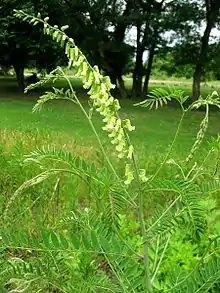| Sophora flavescens | |
|---|---|
 | |
| Scientific classification | |
| Kingdom: | Plantae |
| Clade: | Tracheophytes |
| Clade: | Angiosperms |
| Clade: | Eudicots |
| Clade: | Rosids |
| Order: | Fabales |
| Family: | Fabaceae |
| Subfamily: | Faboideae |
| Genus: | Sophora |
| Species: | S. flavescens |
| Binomial name | |
| Sophora flavescens | |
Sophora flavescens, the shrubby sophora,[1] is a species of plant in the genus Sophora of the family Fabaceae. This genus contains about 52 species, nineteen varieties, and seven forms that are widely distributed in Asia, Oceania, and the Pacific islands. About fifteen of these species have a long history of use in traditional Chinese medicines.[2]
Growth and cultivation
Sophora flavescens is an evergreen slow growing shrub growing to 1.5 m (4.9 ft) by 1 m (3.3 ft). It is hardy to 0–10 °F (−18 – −12 °C) and to US zone 6. The plant prefers light (sandy), medium (loamy) and heavy (clay) soils and requires well-drained soil. The plant prefers acid, neutral and basic (alkaline) soils. It cannot grow in the shade. It requires moist soil. Like many other species in the family Fabaceae, this species can fix nitrogen.
Chemistry

Chemical compounds isolated from S. flavescens include:
- Matrine and matrine oxide, quinolizidine alkaloids found in the roots
- Kushenin, a pterocarpan and isoflavonoid[3]
- Sophoraflavanone G[4]
- 7,9,2',4'-Tetrahydroxy-8-isopentenyl-5-methoxychalcone[5]
- Sophoridine
- Kurarinone[6]
- Trifolirhizin, a pterocarpan flavonoid, isolated from the roots
- 8-Prenylkaempferol, a prenylflavonoid
- Oxysophocarpine and sophocarpine, alkaloids[7]
Toxicity
Toxic effects from use of the root may include nausea, dizziness, vomiting, constipation, spasms, disturbance of speech, irregular breathing, respiratory failure and death.[8]
References
- ↑ USDA, NRCS (n.d.). "Sophora flavescens". The PLANTS Database (plants.usda.gov). Greensboro, North Carolina: National Plant Data Team. Retrieved 21 November 2015.
- ↑ Krishna, Panthati Murali; Knv, Rao; S, Sandhya; Banji, David (2012). "A review on phytochemical, ethnomedical and pharmacological studies on genus Sophora, Fabaceae". Revista Brasileira de Farmacognosia. 22 (5): 1145–1154. doi:10.1590/S0102-695X2012005000043.
- ↑ Schwarte A 2002 Phytochemische und pharmakologische Untersuchungen der Wurzeln von Sophora flavescens,unter besonderer Berücksichtigung ihrer Wirkung auf die Leukotrien- und Prostaglandinbiosynthese Archived 14 August 2011 at the Wayback Machine
- ↑ Cha, J.-D.; Moon, S.-E.; Kim, J.-Y.; Jung, E.-K.; Lee, Y.-S. (2009). "Antibacterial activity of sophoraflavanone G isolated from the roots of Sophora flavescens against methicillin-resistant Staphylococcus aureus". Phytotherapy Research. 23 (9): 1326–1331. doi:10.1002/ptr.2540. PMID 19288534. S2CID 3033936.
- ↑ Choi, Byung-Min; Oh, Gi-Su; Lee, Jang Won; Mok, Ji Ye; Kim, Dae Keun; Jeong, Seung-Il; Jang, Seon Il (2010). "Prenylated chalcone from Sophora flavescens suppresses Th2 chemokine expression induced by cytokines via heme oxygenase-1 in human keratinocytes". Archives of Pharmacal Research. 33 (5): 753–760. doi:10.1007/s12272-010-0515-8. PMID 20512474. S2CID 41527720.
- ↑ Tang KT, Lin CC, Lin SC, Wang JH, Tsai SW (2021). "Kurarinone Attenuates Collagen-Induced Arthritis in Mice by Inhibiting Th1/Th17 Cell Responses and Oxidative Stress". Int J Mol Sci. 22 (8): 4002. doi:10.3390/ijms22084002. PMC 8069507. PMID 33924467.
{{cite journal}}: CS1 maint: multiple names: authors list (link) - ↑ Liu, G.; Dong, J.; Wang, H.; Hashi, Y.; Chen, S. (2011). "Characterization of alkaloids in Sophora flavescens Ait. by high-performance liquid chromatography-electrospray ionization tandem mass spectrometry". Journal of Pharmaceutical and Biomedical Analysis. 54 (5): 1065–1072. doi:10.1016/j.jpba.2010.12.024. PMID 21227622.
- ↑ Bensky, Dan; Clavey, Steven; Stöger, Erich; Lai Bensky, Lilian (2015). Chinese Herbal Medicine: Materia Medica (Portable 3rd ed.). Seattle, USA: Eastland Press. pp. 575–578. ISBN 978-0-939616-82-4.
External links
- Sophora flavescens Ait.
- Ya Ling, Jian; Ying Zhang, Guo; Jie Cui, Zhao; Kai Zhang, Chang (2007). "Supercritical fluid extraction of quinolizidine alkaloids from Sophora flavescens Ait. and purification by high-speed counter-current chromatography" (PDF). Journal of Chromatography A. 1145 (1–2): 123–127. doi:10.1016/j.chroma.2007.01.080. PMID 17289059.